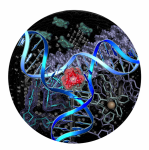Cellular and nuclear targeting of metallo-drugs and
imaging agents
Metallo-drugs
For a review on the current strategies being investigated in
metallo-drug
design see:
Pure and Applied
Chemistry, 2007, 79, 2243-2261

Schematic illustrating approach (a)
Platinum metallo-drugs (such as cis-platin) are important
and effective tools in the treatment
of cancers and have potential application as anti-viral agents.
Problems associated with these drugs include a range of
unpleasant/toxic side-effects, a lack of efficacy against certain types
of cancers and the development of cis-platin resistance. The first two
problems may potentially be alleviated by more effective targeting of
the drug to the desired site of action and we are exploring several
distinct approaches to enhanced targeting of metallo-drugs and
metallo-imaging agents:
A) Steroids
We are exploring steroids as vectors to achieve cellular and nuclear
delivery of metallo-drugs. We have demonstrated the efficacy of this
approach by using estrogens to deliver a variety of different
(potentially radiotherapeutic) metal centres into the nuclei of cells.
The approach not only harnesses established steroid transport pathways,
but also offers potential for active tissue targeting by using
sex-hormone steroids which localise in specific tissues. The
current focus of this work is the use of steroids to deliver classical
and non-classical platinum-drugs into specific cell nuclei. In addition
to cell line cytotoxicity testing we also study and characterise the
interactions with albumins, steroid receptors, nucleo-bases and DNAs to
explore the molecular level action(s) of the drugs. We employ various
techniques include various spectroscopies (such as circular and linear
dichroism) ESI-FTICR mass spectrometry, gel electrophoresis, AFM. The
project benefits from a range of European collaborations with
bioinorganic chemists, molecular and cellular biologists and
clinicians.
For examples of our
work in this area see
Chem. Eur. J., 2006, 12, 8000-8013
Inorg. Chem.,
2001, 40,
3964-3973

A steroidal metallo-drug
B) Commercial collaborations
We are also exploring localised drug delivery of metallo-drugs and
imaging agents with
several UK-based industrial companies who are funding or have funded
postdoctoral researchers in the group. Much of the work is commercially
sensitive and cannot be disclosed at this time, however one co-authored
patent has appeared.
For one example of our
our work in this area see Patent PCT/GB01/03739 WIPO
C) Nanotechnology
The use of nanocarriers is a promising route for drug delivery,
offering a high loading into a
discrete package, enhanced stability and in some cases solubility of
the drug. The ability to tune the size and surface properties of the
nanocarriers has been widely used to enhance cellular uptake; size,
targeting groups, surface charge and morphology can all be optimised
for given cell types.
Of the nanotechnology
available gold nanoparticles provide
attractive vehicles for metallodrugs as they feature low
core toxicity, and can be made in a wide range of sizes with controlled
polydispersity. The surface can then readily be modified through
thiol-gold linkages, providing a wide array of possible
functionalities. We are seeking to harness the potential of
nanotechnology for the delivery of a variety of metallodrugs.
Imaging agents
Delivery of imaging agents into cells is a desirable part of many
pre-clinical and clinical applications, ranging across drug
development, clinical diagnostics and cellular therapies. We are
investigating ways to label cells and their internal structures for
imaging by a range of modalities. We aim to observe the cells using
fluorescence microscopies, flow cytometry and MRI with high efficiency
and low cytotoxicity. Methods for achieving this range from
in vivo protein labeling to using
the benefits of nanotechnology to deliver high payloads of multimodal
imaging agents.



